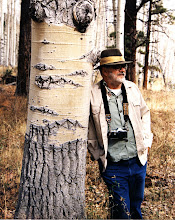
The Eagle and Bluebell mine is an old mine in Eureka, Utah. Silver and/or gold was found in this area in the 1860's and the Tintic Mining District organized in 1869. The Eagle and Bluebell was begun around this time although under a different name. About 1897 it was purchased by the Bingham Mining Co, the same company that developed the huge copper mine in the Salt Lake Valley. The Eagle and Bluebell sits about halfway up the mountain to the south of the town of Eureka. Over time a very large tailings dump developed. A railroad spur was brought in to allow ore to be loaded directly from ore bins and transported to a smelter/mill. Between 1897 and 1916 220,000 tons of ore was taken out of this mine. From this ore 35,000 ounces of gold, 3.2 million ounces of silver, 1.4 million pounds of copper, 34 million pounds of lead and 23,000 pounds of zinc were extracted.

The photo above shows the Eagle and Bluebell surface plant.The head frame is positioned over the shaft; to the left the grayish building houses the hoist, basically an electrical winch, by which men and equipment are raised and lowered into the mine. The photo below shows the interior of the hoist room with the massive hoist.

The next photo shows the belt/cable running from the hoist out of the building. This belt goes over the wheel at the top of the head frame and attaches to the cage containing the men or equipment. The two large discs are part of the method by which the depth of the cages in the shaft was determined.

For me the most intriguing thing about the Eagle and Bluebell was the ore bins, shown below. Mine cars were run out onto the top and then dumped down chutes into the ore bins. The railroad track ran between the bins. The construction is massive. Many of these timbers are tree trunks. I do not know when this was constructed, but I believe it was early in the 20th century.

Below is a photo taken in the space between the ore bins where the train ran.

Below are two views from the top with Eureka in the valley below.


Below is the top of the ore bin structure without the shack. The tracks lead to the chutes via which the ore was dumped from the mine cars into the bins.

This is the shack on top of the bins. I don't think anyone will be running any mine cars out there any time soon.

The Eureka mines ran off and on during the great depression, then full bore through World War II. After that some of them ran sporadically into the 1970's.
My grandfather ran the substation for the electric company from 1917 until his retirement in the 1950's. His house and the sub were just down the hill and to the east of the Eagle and Bluebell. The miners generally walked to work and had worn a trail in the snow about wide enough for a man to walk on. This trail got nicely packed down and was a great sled run for my dad and his friends, at least until they encountered a couple of miners on their way to work. Miners and lunch buckets flew everywhere. Being wise and afraid of the consequences, the boys kept going.
A note on the photographs--I have photographed in and around Eureka several times over the years, although not recently. The only recent photo I could find on the internet of the ore bins was taken in 2006 and showed the top shack gone. I'm not sure what else has gone on in the interim. I guess I need to have another go at Eureka.
The photographs shown here were all taken in 1990, when I got permission from the caretaker to be on the property. The photos were all originally in color, 35mm transparency film, probably Fuji. They were scanned using a Minolta film scanner. The black and white conversions were done with Silver Efex Pro 2

Wow! That b/w looks really great! I'm no expert but they really remind me of the silver gelatin prints.
ReplyDeleteThe EPA has done their dirty work and destroyed much mining history around Eureka.
ReplyDeleteMy father worked at both the Eagle and Bluebell mines as a young man, starting at 16 years of age, while still in high school. After graduation, he worked steady for many years. I appreciate these pictures, so I can see the actual mines he greatly described in his life story. Thanks!!!
ReplyDeleteYou are very welcome.
DeleteI would love a calendar. Do you have any left?
ReplyDeleteM'Lisa Long
I cannot find an email address to contact you privately - I am wondering if I may get your permission to use some of your photos on a website. Please let me know if you do allow this. Thanks.
ReplyDeleteWere you able to find permissions? I am looking for the same thing
Delete